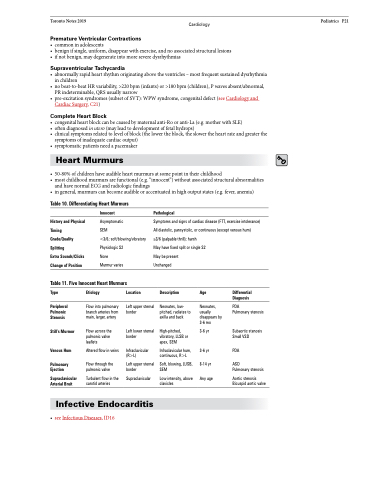Page 1055 - TNFlipTest
P. 1055
Toronto Notes 2019 Cardiology Pediatrics P21
Premature Ventricular Contractions
• commoninadolescents
• benignifsingle,uniform,disappearwithexercise,andnoassociatedstructurallesions • ifnotbenign,maydegenerateintomoreseveredysrhythmias
Supraventricular Tachycardia
• abnormallyrapidheartrhythmoriginatingabovetheventricles–mostfrequentsustaineddysrhythmia in children
• nobeat-to-beatHRvariability,>220bpm(infants)or>180bpm(children),Pwavesabsent/abnormal, PR indeterminable, QRS usually narrow
• pre-excitationsyndromes(subsetofSVT):WPWsyndrome,congenitaldefect(seeCardiologyand Cardiac Surgery, C21)
Complete Heart Block
• congenitalheartblockcanbecausedbymaternalanti-Rooranti-La(e.g.motherwithSLE)
• oftendiagnosedinutero(mayleadtodevelopmentoffetalhydrops)
• clinicalsymptomsrelatedtolevelofblock(thelowertheblock,theslowertheheartrateandgreaterthe
symptoms of inadequate cardiac output) • symptomaticpatientsneedapacemaker
Heart Murmurs
• 50-80%ofchildrenhaveaudibleheartmurmursatsomepointintheirchildhood
• mostchildhoodmurmursarefunctional(e.g.“innocent”)withoutassociatedstructuralabnormalities
and have normal ECG and radiologic findings
• ingeneral,murmurscanbecomeaudibleoraccentuatedinhighoutputstates(e.g.fever,anemia)
Table 10. Differentiating Heart Murmurs
History and Physical Timing Grade/Quality Splitting
Extra Sounds/Clicks Change of Position
Innocent
Asymptomatic
SEM
<3/6; soft/blowing/vibratory Physiologic S2
None
Murmur varies
Pathological
Symptoms and signs of cardiac disease (FTT, exercise intolerance) All diastolic, pansystolic, or continuous (except venous hum)
≥3/6 (palpable thrill); harsh
May have fixed split or single S2
Table 11. Five Innocent Heart Murmurs
May be present Unchanged
Description
Neonates, low- pitched, radiates to axilla and back
High-pitched, vibratory, LLSB or apex, SEM
Infraclavicular hum, continuous, R>L
Soft, blowing, LUSB, SEM
Low intensity, above clavicles
Type
Peripheral Pulmonic Stenosis
Still’s Murmur
Venous Hum
Pulmonary Ejection
Supraclavicular Arterial Bruit
Etiology
Flow into pulmonary branch arteries from main, larger, artery
Flow across the pulmonic valve leaflets
Altered flow in veins
Flow through the pulmonic valve
Turbulent flow in the carotid arteries
Location
Left upper sternal border
Left lower sternal border
Infraclavicular (R>L)
Left upper sternal border
Supraclavicular
Age
Neonates, usually disappears by 3-6 mo
3-6 yr
3-6 yr 8-14 yr Any age
Differential Diagnosis
PDA
Pulmonary stenosis
Subaortic stenosis Small VSD
PDA
ASD
Pulmonary stenosis
Aortic stenosis Bicuspid aortic valve
Infective Endocarditis
• seeInfectiousDiseases,ID16


